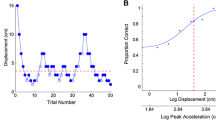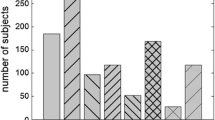Abstract
Cervical and ocular vestibular-evoked myogenic potential (cVEMP/oVEMP) tests are widely used clinical tests of otolith function. However, VEMP testing may not be the ideal measure of otolith function given the significant inter-individual variability in responses and given that the stimuli used to elicit VEMPs are not physiological. We therefore evaluated linear motion perceptual threshold testing compared with cVEMP and oVEMP testing as measures of saccular and utricular function, respectively. A multi-axis motion platform was used to measure horizontal (along the inter-aural and naso-occipital axes) and vertical motion perceptual thresholds. These findings were compared with the vibration-evoked oVEMP as a measure of utricular function and sound-evoked cVEMP as a measure of saccular function. We also considered how perceptual threshold and cVEMP/oVEMP testing are each associated with Dizziness Handicap Inventory (DHI) scores. We enrolled 33 patients with bilateral vestibulopathy of different severities and 42 controls to have sufficient variability in otolith function. Subjects with abnormal oVEMP amplitudes had significantly higher (poorer) perceptual thresholds in the inter-aural and naso-occipital axes in age-adjusted analyses; no significant associations were observed for vertical perceptual thresholds and cVEMP amplitudes. Both oVEMP amplitudes and naso-occipital axis perceptual thresholds were significantly associated with DHI scores. These data suggest that horizontal perceptual thresholds and oVEMPs may estimate the same underlying physiological construct: utricular function.



Similar content being viewed by others
References
Agrawal Y, Zuniga MG et al (2012) Decline in semicircular canal and otolith function with age. Otol Neurotol 33(5):832–839
Benson AJ, Spencer MB et al (1986) Thresholds for the detection of the direction of whole-body, linear movement in the horizontal plane. Aviat Space Environ Med 57(11):1088–1096
Brantberg K, Lofqvist L et al (2008) Skull tap induced vestibular evoked myogenic potentials: an ipsilateral vibration response and a bilateral head acceleration response? Clin Neurophysiol 119(10):2363–2369
Brantberg K, Westin M et al (2009) Vestibular evoked myogenic potentials in response to lateral skull taps are dependent on two different mechanisms. Clin Neurophysiol 120(5):974–979
Clarke AH (2001) Perspectives for the comprehensive examination of semicircular canal and otolith function. Biol Sci Space 15(4):393–400
Clarke AH, Schonfeld U et al (2003) Unilateral examination of utricle and saccule function. J Vestib Res 13(4–6):215–225
Colebatch JG (2010) Sound conclusions? Clin Neurophysiol 121(2):124–126
Curthoys IS (2010) A critical review of the neurophysiological evidence underlying clinical vestibular testing using sound, vibration and galvanic stimuli. Clin Neurophysiol 121(2):132–144
Curthoys IS (2012) The interpretation of clinical tests of peripheral vestibular function. Laryngoscope 122(6):1342–1352
Grabherr L, Nicoucar K et al (2008) Vestibular thresholds for yaw rotation about an earth-vertical axis as a function of frequency. Exp Brain Res 186(4):677–681
Halmagyi GM, Aw ST et al (2003) Superior semicircular canal dehiscence simulating otosclerosis. J Laryngol Otol 117(7):553–557
Halmagyi GM, Curthoys IS (1988) A clinical sign of canal paresis. Arch Neurol 45(7):737–739
Iwasaki S, Chihara Y et al (2009) The role of the superior vestibular nerve in generating ocular vestibular-evoked myogenic potentials to bone conducted vibration at Fz. Clin Neurophysiol 120(3):588–593
Iwasaki S, Smulders YE et al (2008) Ocular vestibular evoked myogenic potentials to bone conducted vibration of the midline forehead at Fz in healthy subjects. Clin Neurophysiol 119(9):2135–2147
Jacobson GP, Newman CW (1990) The development of the Dizziness Handicap Inventory. Arch Otolaryngol Head Neck Surg 116(4):424–427
Jorns-Haderli M, Straumann D et al (2007) Accuracy of the bedside head impulse test in detecting vestibular hypofunction. J Neurol Neurosurg Psychiatry 78(10):1113–1118
Kingma H (2005) Thresholds for perception of direction of linear acceleration as a possible evaluation of the otolith function. BMC Ear Nose Throat Disord 5(1):5
Leek MR (2001) Adaptive procedures in psychophysical research. Percept Psychophys 63(8):1279–1292
MacNeilage PR, Banks MS et al (2010a) Vestibular heading discrimination and sensitivity to linear acceleration in head and world coordinates. J Neurosci 30(27):9084–9094
MacNeilage PR, Turner AH et al (2010b) Canal-otolith interactions and detection thresholds of linear and angular components during curved-path self-motion. J Neurophysiol 104(2):765–773
Mallery RM, Olomu OU et al (2010) Human discrimination of rotational velocities. Exp Brain Res 204(1):11–20
Merfeld DM (2011) Signal detection theory and vestibular thresholds: I. Basic theory and practical considerations. Exp Brain Res 210(3–4):389–405
Merfeld DM, Priesol A et al (2010) Potential solutions to several vestibular challenges facing clinicians. J Vestib Res 20(1):71–77
Minor LB (1998) Gentamicin-induced bilateral vestibular hypofunction. Jama 279(7):541–544
Nguyen KD, Welgampola MS et al (2010) Test-retest reliability and age-related characteristics of the ocular and cervical vestibular evoked myogenic potential tests. Otol Neurotol 31(5):793–802
Proctor L, Dix R et al (1975) Stimulation of the vestibular receptor by means of step temperature changes during continuous aural irrigation. Acta Otolaryngol 79(5–6):425–435
Rauch SD, Velazquez-Villasenor L et al (2001) Decreasing hair cell counts in aging humans. Ann N Y Acad Sci 942:220–227
Roditi RE, Crane BT (2012) Directional asymmetries and age effects in human self-motion perception. J Assoc Res Otolaryngol 13(3):381–401
Rosenhall U (1973) Degenerative patterns in the aging human vestibular neuro-epithelia. Acta Otolaryngol 76(2):208–220
Smulders YE, Welgampola MS et al (2009) The n10 component of the ocular vestibular-evoked myogenic potential (oVEMP) is distinct from the R1 component of the blink reflex. Clin Neurophysiol 120(8):1567–1576
Streubel SO, Cremer PD et al (2001) Vestibular-evoked myogenic potentials in the diagnosis of superior canal dehiscence syndrome. Acta Otolaryngol Suppl 545:41–49
Todd, N. P., S. L. Bell, et al. (2012). Contributions of ocular vestibular evoked myogenic potentials (OVEMPs) and the electro-oculogram (EOG) to periocular potentials produced by whole-body vibration. J Appl Physiol 113(10):1613–1623
Valko Y, Lewis RF et al (2012) Vestibular labyrinth contributions to human whole-body motion discrimination. J Neurosci 32(39):13537–13542
Wei W, Jeffcoat B et al (2013) Frequency tuning of the cervical vestibular-evoked myogenic potential (cVEMP) recorded from multiple sites along the sternocleidomastoid muscle in normal human subjects. J Assoc Res Otolaryngol 14(1):37–47
Welgampola MS, Carey JP (2010) Waiting for the evidence: VEMP testing and the ability to differentiate utricular versus saccular function. Otolaryngol Head Neck Surg 143(2):281–283
Welgampola MS, Colebatch JG (2005) Characteristics and clinical applications of vestibular-evoked myogenic potentials. Neurology 64(10):1682–1688
Welgampola MS, Migliaccio AA et al (2009) The human sound-evoked vestibulo-ocular reflex and its electromyographic correlate. Clin Neurophysiol 120(1):158–166
Wichmann FA, Hill NJ (2001a) The psychometric function: II. Bootstrap-based confidence intervals and sampling. Percept Psychophys 63(8):1314–1329
Wichmann FA, Hill NJ (2001b) The psychometric function: I. Fitting, sampling, and goodness of fit. Percept Psychophys 63(8):1293–1313
Zhang AS, Govender S et al (2011) Tuning of the ocular vestibular evoked myogenic potential (oVEMP) to AC sound shows two separate peaks. Exp Brain Res 213(1):111–116
Zhang AS, Govender S et al (2012) Tuning of the ocular vestibular evoked myogenic potential to bone-conducted sound stimulation. J Appl Physiol 112(8):1279–1290
Zhu H, Tang X et al (2011) Click-evoked responses in vestibular afferents in rats. J Neurophysiol 106(2):754–763
Zingler VC, Cnyrim C et al (2007) Causative factors and epidemiology of bilateral vestibulopathy in 255 patients. Ann Neurol 61(6):524–532
Acknowledgments
The authors would like to acknowledge Dr. Thomas Brandt for his valuable contributions and the peer reviewers for their thoughtful comments.
Author information
Authors and Affiliations
Corresponding author
Rights and permissions
About this article
Cite this article
Agrawal, Y., Bremova, T., Kremmyda, O. et al. Clinical Testing of Otolith Function: Perceptual Thresholds and Myogenic Potentials. JARO 14, 905–915 (2013). https://doi.org/10.1007/s10162-013-0416-x
Received:
Accepted:
Published:
Issue Date:
DOI: https://doi.org/10.1007/s10162-013-0416-x




